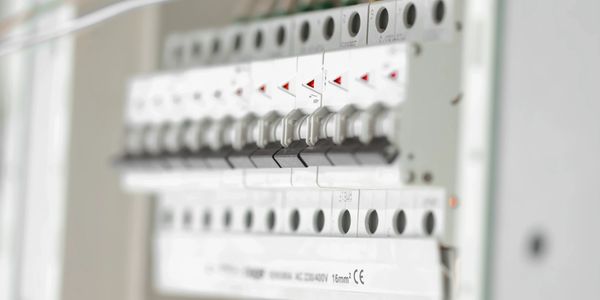Most of us worry about what we can see around the home: chipped paint, a leaky tap, or creaking floorboards. What many people overlook is the condition of the wiring hidden behind the walls.
Safe wiring is the backbone of every home, and it’s what keeps the lights bright and appliances running. When it starts to fail, the risks go beyond inconvenience. Outdated wiring can be a genuine fire hazard. If you have wondered whether your home might need electrical rewiring, these ten signs are worth paying attention to.

Why Rewiring Matters
Older homes were built at a time when electrical demand was far lower. A couple of light fittings and a television once covered most household needs, but modern living means multiple appliances and smart technology all competing for power.
Outdated systems often cannot cope, which not only makes everyday life frustrating but also increases the risk of shocks and electrical fires. Recognising the warning signs helps you decide if your house may be due for a professional check or even a full electrical rewire.
1. Frequent Tripping of Circuit Breakers
If your circuit breakers or safety switches trip repeatedly, especially when several appliances are running, the system is likely under too much strain. While occasional tripping is normal, a persistent pattern usually signals wiring that is overloaded or deteriorating.
Older-style fuses blowing regularly fall into the same category. Both are strong indicators that professional electrical rewiring may be required.
2. Flickering or Dimming Lights
When lights flicker, dim, or suddenly brighten, it is tempting to blame the bulb. However, if the problem occurs across several fittings or coincides with appliances being switched on, it points to wiring or circuit issues.
In some cases, lightbulbs that burn out unusually quickly also suggest unstable voltage or loose connections.
3. Discoloured or Warm Power Points
Power points and light switches should never feel hot. If they are warm to the touch or show brown or yellow marks, it could mean the wires behind them are overheating.
Loose connections and degrading insulation are often to blame. If left unchecked, they can lead to arcing, where electricity jumps across gaps in the wiring and produces enough heat to ignite surrounding materials, sometimes resulting in household fires.
4. Burning Smell or Buzzing Sounds
Electrical systems should be silent and odourless. Any unusual odour or sound is often your first sign that something is wrong behind the walls.
A faint burning smell near outlets or the switchboard may point to wires overheating or sparking. Likewise, a buzzing sound from switches, lights, or appliances can signal damaged insulation or loose connections, both of which require urgent inspection before they become serious hazards.
5. Old Two-Prong Outlets or Missing Earth Wires
Older homes sometimes still have two-prong outlets. These lack the extra hole you see in modern three-prong points, which is there for safety.
That third slot connects to the earth and gives stray electricity somewhere safe to go. Without it, you are more likely to get an electric shock, and your appliances are at greater risk of damage.
6. Outdated Switchboards
Switchboards are central to your home’s electrical safety. If yours still relies on ceramic fuses or does not include safety switches, it is a sign that electrical rewiring is overdue.
Modern switchboards include residual current devices that shut down the circuit instantly if a fault is detected. In many cases, switchboard upgrades are required to meet current safety standards.
7. Aluminium Wiring
Homes built in the 1960s and 1970s sometimes used aluminium wiring instead of copper. While it was cheaper at the time, aluminium expands and contracts more, which loosens connections over the years. Loose connections increase the chance of overheating or sparking, making this type of wiring a known risk today.
8. Rodent Damage
Rats and mice often chew through wires hidden in walls or ceilings. Even small sections of exposed copper can create short circuits or become ignition points.
If you have dealt with rodents in your home before, it is wise to have the wiring inspected for hidden damage.
9. Tricky or Sparking Power Points
Sockets that work only some of the time, spark when used, or fail completely are a clear sign of wiring problems. Causes can include corroded terminals or loose internal parts.
Relying on these outlets is unsafe. It is often a signal that the system behind them is deteriorating.
10. An Older Home Without a Recent Electrical Check
Even if there are no obvious warning signs, age alone can mean electrical wiring needs attention. Materials degrade over time, and wiring installed decades ago was never designed for the heavy electrical loads of today.
If your home is more than 30 years old and has not had an inspection, it is sensible to book one. Many older properties ultimately require a full electrical rewire to meet today’s standards.
What To Do If You Notice These Signs
Spotting one of these issues does not automatically mean your home is unsafe, but it does mean you should not ignore it. The safest step is to call a licensed electrician for a full inspection. From there, you will know if small repairs are enough or whether rewiring electrical in house is necessary to protect your home and family.
Protecting Your Home Starts With an Inspection
Your home’s wiring works silently in the background every day, but when it begins to fail, the risks are serious. Acting early saves you stress, money, and potential hazards in the long run.
If you have noticed any of these signs or if your property has simply reached the age where an electrical rewiring might be due, speak with a licensed and insured electrician. Peace of mind is well worth the investment.
